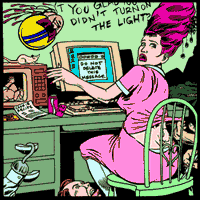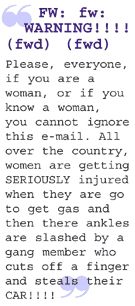|
FEBRUARY 2000 | VOL. 4, NO. 2 THAT'S LIFE
RELATED ARTICLES RECENT ESSAY ANNIE L. CLARK FERREIRA, a linguist who works in Tewksbury, MA, is a contributing writer to Renaissance Online Magazine. PETER S. CONRAD is a cartoonist and illustrator in Northern California.
FULL ISSUE CONTENTS |
ANNIE L. CLARK FERREIRA
Urban legends have completely taken over our society of late. Why?
The answer lies in our worst enemy who is also our best friend: the
Internet. Information, whether accurate or false, can now be so rapidly
disseminated that there is no time for fact-checking or validation. And
for some reason, people seem completely willing to believe anything they
read on the Internet or in their e-mail. Most e-mail users have received an e-mail titled "FW: Urgent
Warning!!! (fwd)" at some point. These messages always have several
exclamation points and are always "urgent" or "important." Many warn of
viruses which can be sent through e-mail and if opened will destroy your
hard drive, eat your cat and kill all your house plants. However, system
administrators, computer techs, and the good folks at Microsoft will
tell you that the viruses which have such destructive potential are few
and far between. The Melissa virus, which was well-documented in the
media, was only able to send out multiple copies of a document, not, as
hoaxsters claim in many other "virus warning" e-mails, "completely
destroy your computer!!"
It could be the fear of the unknown that keeps us believing these messages are real. Most of us have at least one brush with the dreadful experience of a hard drive crash seconds before completing a time consuming project, losing all the data. We have been warned so many times to save and back-up our documents in case of a crash that we take every warning literally. That, indeed, is a heavy fear. So we believe every warning we get in our mailbox, because it might be true, and that would be the worst thing to happen, wouldn't it? However, virus warnings are not the only fanciful e-mails to infiltrate our cyber culture. Why do people believe all the lies which come through their e-mail? Why do they accept them at face value and send them on to everyone they know? Again, we look to fear of The Great Unknown. These urban legends have such a power over us because they tend to prey on our real fears. They talk about gangs infiltrating the suburbs and killing and maiming people. They talk about people drugging and killing our children. They talk about getting infected with AIDS (what could be more terrifying than that?). Furthermore, when we receive e-mails from people we know and trust, we believe them (the e-mails). To define and recognize an urban legend, a short history of myths and legends is necessary. Santa Claus is a myth. Children everywhere believe in the jolly old man who will break into their homes and leave toys. King Arthur and the Knights of the Round Table is a legend. The tale has been passed down orally and then transcribed for a thousand years. It has become twisted and changed. But many historians claim that there was a real king or chieftain in England who was the original King Arthur. Most legends, and even myths, have some basis in fact. For that matter, the Holy Bible, the Torah and Koran are all legends: tales of what happened long ago, passed down orally and then written down, for thousands of years (two thousand, isn't that right?). Small details get lost or changed, a big man becomes a giant, the birth of a child gets moved to late December to coincide with the pagan solstice rituals. But the truth and the gist of the tale is saved, remembered and passed on. Urban legends follow a similar process. They are called urban legends because they are the product of an industrial society, and are often linked to urban regions or suburbia. They are recent, and they may have some basis in fact. In the fifties and sixties they were passed around orally. This oral tradition continued until the advent of computers, when they became written, and now they are passed on quickly, faster than any virus, through e-mail. It has often been said that people will believe the written word: "If it's in the newspaper it must be true." And now, if it's in an e-mail, it must certainly be true. I don't have to look it up or ask anyone else, for there it is in black and white (or whichever default color settings your monitor uses). Many teenagers are responsible for passing legends around in high school. Don't you remember talking about the girl who was intimate with the frozen hotdog? What about the girl with the case of maggots and/or fruit flies because of the use of another food? Didn't you know someone who had a cousin who knew a girl that this really happened to? How about in the early '80s when we feared the lick & stick tattoos that had LSD on them? But never once did the LSD warning show up in the news. Interesting. That, as it turns out, is one of the best indications of an urban legend. If you hear about it all over, from a bunch of different e-mails, and yet never read about it in the Boston Globe or New York Times, never hear about it on NBC Nightly News, then you are pretty safe in assuming it's false. [ CONTINUED: discrediting the legends ] | ||||||
ILLUSTRATION by Peter S. Conrad for Renaissance Online Magazine | |||||||


